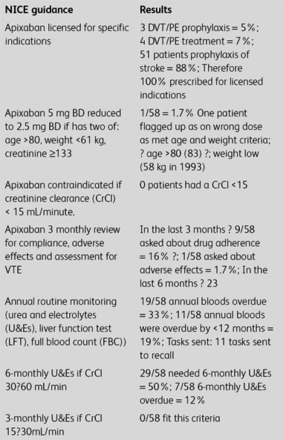A quality improvement project conducted in a GP practice in Greater Manchester to improve the monitoring and safety of patients on apixaban

Introduction
Apixaban is a direct oral anticoagulant inhibitor (DOAC) that prevents thrombin generation and thrombus development.1 As per National Institute for Health and Care Excellence (NICE) guidelines, those taking apixaban require regular follow up and monitoring due to significant safety issues such as bleeding or renal impairment.1-3
In many general practitioner (GP) practices, including Kildonan House, monthly drug safety audits are carried out5 and reviewed by the pharmacists. These reports ensure high-risk medications that require regular monitoring are not overlooked as without these requirements prescribers should not be authorising further medication.5
However, although rivaroxaban, another DOAC was reviewed, as well as lithium and amiodarone, apixaban was not included. I wanted to put measures in place to improve the system to meet these standards and improve the monitoring and thus safety of patients on apixaban.
Materials and methods
I conducted the project using Plan, Do, Study, Act quality improvement methodology: a driver diagram was created; outcome and process measures were outlined; a search was conducted on the electronic patient notes; a meeting was set up with the pharmacists to continue implementing the changes made on the electronic system to start monitoring and recalling patients requiring review.
The search was conducted using SystemOne on all patients currently prescribed apixaban 5 mg twice daily and checking:
if they have a valid indication4
if they are on the correct corresponding dose1–3
they have been appropriately reviewed in the last 6 months
whether their monitoring blood tests in the last 12 months are up to date.
The data was collected and analysed and a results table was created for the following parameters:
Age of patient
Indication
Weight recorded with date
Date of bloods (renal function, liver function, full blood count)
If they fit the criteria for 6 monthly renal function bloods
Whether any bloods are overdue
Actions taken from the data collected for each patient
Whether a review of compliance/side effect was carried out recently.
 |
Results and discussion
100% of the patients were prescribed apixaban appropriately and only 1/58 patients was queried as a possible candidate requiring a reduced dose depending on a more recent weight confirming <61 kg criterion met. All others were dosed appropriately with the information available.
However, it is evident that we are not meeting standards in the monitoring of apixaban bloods routinely. 33% of the routine annual bloods were overdue, 19% of which were >12 months overdue. Only 17% were asked about adverse effects in the last 6 months, and only one of these patients was actually asked in the last 3 months fitting the guidelines. We performed better on documenting drug compliance checked, with 40% done in the last 6 months but these were all mostly part of complete medication reviews or secondary care reviews rather than apixaban-specific consultations.
I involved practice members to illustrate the importance of adding apixaban to the monthly drug safety report and the following implementations and recommendations were made.
Add following patient status recall messages:
all on apixaban need annual U&Es, LFTs, FBC and CrCl
all with CrCl 30–60 need 6-monthly U&Es
all with CrCl 15–30 need 3-monthly U&Es
all with CrCl <15 need apixaban stopped and review
need updated weight every 5 years for ALL adults.
Add apixaban on to monthly drug safety report.
Pharmacists to check during yearly reauthorisation if all routine annual tests completed.
Pharmacists to review and consider discussing with CCG (clinical commissioning group) about safe prescribing for apixaban and implementing assessment of compliance and adverse effects.
Conclusion
There is a real risk in drug safety if monitoring requirements are not met as patients are reliant on the prescribing team for authorising their medication as suitable. Although all prescriptions were currently safe, as an ongoing process, the system will now have a fixed report for any patients at risk on apixaban to be identified. Due to the messages flashing on the patient notes they will be more likely to get actioned by staff to change doses and obtain overdue bloods; reducing costs of repeated tests, kinder as less venepuncture, and much safer. The pharmacists were in agreement to monitor those patients highlighted and also as part of their annual reauthorisation review to ensure bloods are up to date.
This is therefore a sustainable project and the changes and project have helped to educate the clinicians, pharmacists and patients.
- © Royal College of Physicians 2019. All rights reserved.
References
- ↵
- National Institute for Health and Care Excellence
- ↵
- National Institute for Health and Care Excellence
- ↵
- Medicines.org.uk
- ↵
- National Institute for Health and Care Excellence
- ↵
- Wood S.
Article Tools
Citation Manager Formats
Jump to section
Related Articles
- No related articles found.
Cited By...
- No citing articles found.









